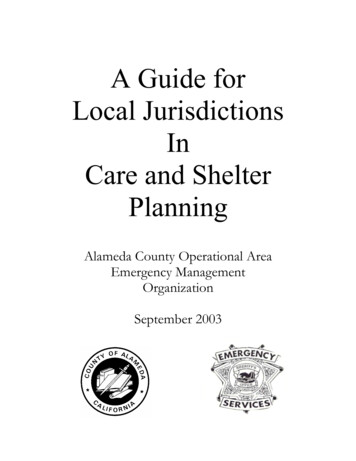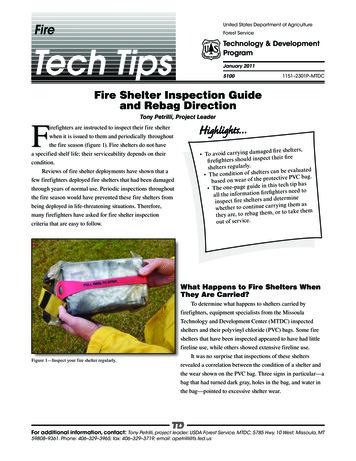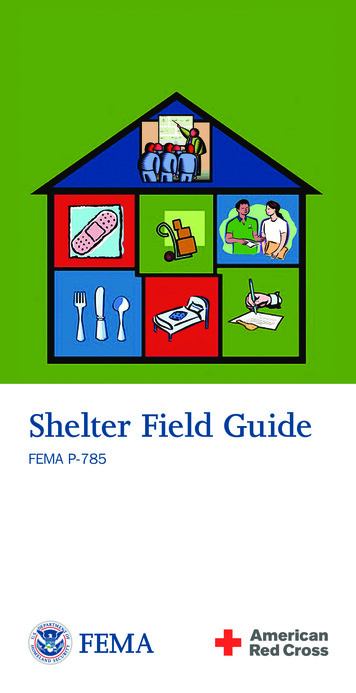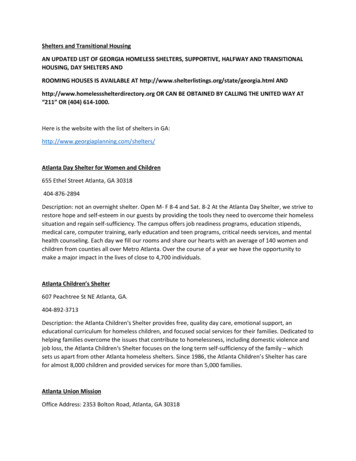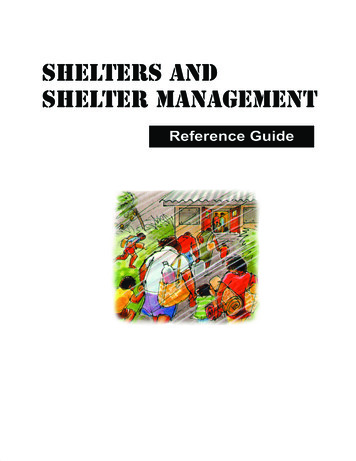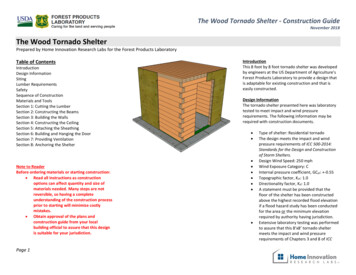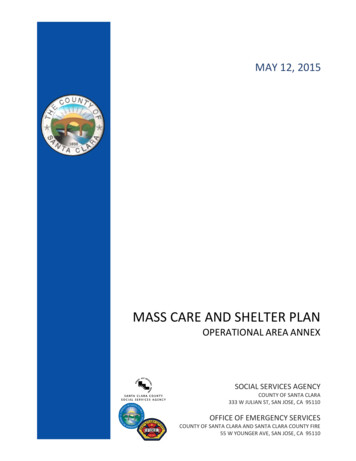
Transcription
MAY 12, 2015MASS CARE AND SHELTER PLANOPERATIONAL AREA ANNEXSOCIAL SERVICES AGENCYCOUNTY OF SANTA CLARA333 W JULIAN ST, SAN JOSE, CA 95110OFFICE OF EMERGENCY SERVICESCOUNTY OF SANTA CLARA AND SANTA CLARA COUNTY FIRE55 W YOUNGER AVE, SAN JOSE, CA 95110
ACKNOWLEDGEMENTSACKNOWLEDGEMENTSThis County of Santa Clara Mass Care and Shelter Plan was sponsored by:Santa Clara County Emergency Operational Area CouncilMass Care and Shelter Ad-hoc Committeechaired by Jason Baker.We would like to acknowledge major contributions from the following cities, countyagencies, and planning partners:American Red CrossOperational Area CitiesCity of GilroyCity of MilpitasCity of Palo AltoCity of San JoséCounty of Santa Clara Departments/AgenciesOffice of Emergency ServicesPublic Health DepartmentSocial Services AgencySOCIAL SERVICES AGENCYCOUNTY OF SANTA CLARAi Page
MASS CARE AND SHELTER PLANOPERATIONAL AREA ANNEX(This page intended to be blank)ii P a g eOFFICE OF EMERGENCY SERVICESCOUNTY OF SANTA CLARA AND SANTA CLARA COUNTY FIRE
TABLE OF CONTENTSMASS CARE AND SHELTER PLANOPERATIONAL AREA ANNEXACKNOWLEDGEMENTS . IPREFACE AND MAINTENANCE . 1PREFACE . 2MAINTENANCE AND REVISION HISTORY . 2PURPOSE, SCOPE, SITUATION, AND ASSUMPTIONS . 3PURPOSE . 4SCOPE . 4SITUATION OVERVIEW . 5ASSUMPTIONS . 6CONCEPT OF OPERATIONS . 9SHELTERING. 10MASS FEEDING . 21BULK DISTRIBUTION . 23FAMILY REUNIFICATION . 28ROLES AND RESPONSIBILITIES . 31OVERVIEW . 32GENERAL ASSIGNMENTS . 34OPERATIONAL AREA EMERGENCY OPERATIONS CENTER (OA EOC) . 34COUNTY AGENCIES SUPPORTING MASS CARE AND SHELTER ACTIVITIES . 37SUPPORTING SPECIAL DISTRICTS . 38SUPPORTING PRIVATE ORGANIZATIONS . 38SUPPORTING STATE AGENCIES . 40SUPPORTING FEDERAL AGENCIES . 42AUTHORITIES . 43FEDERAL . 44SOCIAL SERVICES AGENCYCOUNTY OF SANTA CLARAiii P a g e
MASS CARE AND SHELTER PLANOPERATIONAL AREA ANNEXSTATE . 45LOCAL . 46GLOSSARY . 47ACRONYMS . 48DEFINITIONS . 50APPENDIX A – SHELTER SURVEY FORMS . 1SHELTER FACILITY SURVEY . 2SHELTER ACCESSIBILITY CHECKLIST . 10APPENDIX B – SHELTER OPERATIONS FORMS. 23SHELTER REGISTRATION FORM . 24FACILITY/SHELTER OPENING & CLOSING INSPECTION FORM . 25UNACCOMPANIED MINOR FORM. 27FEEDING DAILY ACTIVITY REPORT . 28FEEDING CONSOLIDATED DAILY REPORT . 29APPENDIX C – AMERICAN RED CROSS MEMORANDUM OF UNDERSTANDING . 31AMERICAN RED CROSS MEMORANDUM OF UNDERSTANDING . 32iv P a g eOFFICE OF EMERGENCY SERVICESCOUNTY OF SANTA CLARA AND SANTA CLARA COUNTY FIRE
PREFACE AND MAINTENANCEPREFACE AND MAINTENANCESOCIAL SERVICES AGENCYCOUNTY OF SANTA CLARA1 Page
MASS CARE AND SHELTER PLANOPERATIONAL AREA ANNEXPREFACE AND MAINTENANCEPREFACEMass care and shelter is an organized way of providing shelter, feeding, sleeping andsanitary accommodations for large numbers of people temporarily displaced from theirresidence by large-scale natural or man-made emergencies or disasters. This plan outlinespolicies and guidelines that will aid in addressing the need for temporary protectiveshelter and feeding of the general population affected by a large-scale emergency, majordisaster, or precautionary evacuation. This plan is general in nature and written toaugment existing checklists and standard operation procedures (SOPs) currently in place.It is the intent of this document to create a framework for preparations, response, andrecovery within existing statutory obligations.This plan does not apply to day-to-day small-scale emergencies. Typically, the localAmerican Red Cross (Red Cross) Chapter is capable of responding to day-to-dayemergencies that require sheltering, using their own resources.MAINTENANCE AND REVISION HISTORYThis Mass Care and Shelter Plan serves as an annex to the County of Santa ClaraOperational Area Emergency Operations Plan (OA EOP). This Mass Care and ShelterPlan is maintained by the County of Santa Clara Social Services Agency and will bereviewed and revised, as necessary every three (3) years.The plan may also be updated after an exercise or changes in procedure, law, rules orregulations pertaining to mass care and shelter operations.Revision RevisionNumberDateInitialReleaseMay 28,2015Section of PlanRevisedRevised byCommentsInitial ReleaseNo. 1No. 2No. 3No. 42 PageOFFICE OF EMERGENCY SERVICESCOUNTY OF SANTA CLARA AND SANTA CLARA COUNTY FIRE
PURPOSE, SCOPE, SITUATION, AND ASSUMPTIONSPURPOSE, SCOPE, SITUATION, AND ASSUMPTIONSSOCIAL SERVICES AGENCYCOUNTY OF SANTA CLARA3 Page
MASS CARE AND SHELTER PLANOPERATIONAL AREA ANNEXPURPOSE, SCOPE, SITUATION AND ASSUMPTIONSPURPOSEThis Mass Care and Shelter Plan is an annex to the County of Santa Clara OperationalArea Emergency Operations Plan (OA EOP) and addresses the actions that will be takenat the operational area (OA) level to mitigate the impact of a major or catastrophicincident on the affected population. This plan describes the provisions to give displacedpersons access to mass care when impacted by a disaster. As defined by the NationalResponse Framework (NRF) Emergency Support Function #6 (ESF #6)—Mass Care,Emergency Assistance, Housing and Human Services Annex and California EmergencyFunction 6 (EF#6) Care and Shelter Annex mass care includes sheltering, feedingoperations, bulk distribution of emergency items, and collecting and providinginformation on victims to family members. This Plan is a functional annex to the OAEOP and works in conjunction with other OA EOP functional annexes. It is alsoconsistent with state emergency plans.SCOPEThe Mass Care and Shelter Plan addresses mass care preparedness, response, andrecovery activities during local and state emergencies, incidents of national significance,and presidentially declared emergencies or major disasters. This plan applies to alloperational area public, private, and non-governmental organizations (NGOs) withoperational responsibilities for mass care. This plan is designed to guide response inemergencies that require the mass care and shelter of affected and displaced individualsat a level that exceeds the established operating capabilities in their affected jurisdiction.All activities are in accordance with the state Standardized Emergency ManagementSystem (SEMS), which has been integrated with the federal National IncidentManagement System (NIMS). SEMS practices used during multi-agency or multijurisdictional emergency management shall be followed. Local governments must useSEMS to be eligible for reimbursement of disaster-related costs.Although not always explicitly stated in the plan, providing services to people withdisabilities, and others with access and functional needs is implicit throughout the plan.There are specific places where access and functional needs are discussed separately, butthese discussions do not imply that these topics are the only ones where these services arecovered. Additionally, for all activities described in this plan the physical, behavioral, andmental health needs of responders will be monitored and addressed, as needed.4 PageOFFICE OF EMERGENCY SERVICESCOUNTY OF SANTA CLARA AND SANTA CLARA COUNTY FIRE
PURPOSE, SCOPE, SITUATION, AND ASSUMPTIONSThe overall objectives of mass care and shelter operations are to: Coordinate and provide food, shelter, emotional support, and other basic disastercaused needs. Coordinate and provide service to reunite separated families or respond toinquiries from relatives and friends outside of the affected areas.The effectiveness of the emergency response is largely predicated on the preparednessand resiliency of the community. This plan was developed in collaboration withstakeholders from operational area cities/towns, Collaborating Agencies Disaster ReliefEffort (CADRE), NGOs, county departments, state agencies and departments, and theRed Cross. These stakeholders represent emergency management; fire service; socialservices; parks and recreation; public health; and access and functional needs serviceproviders.This plan supports a whole community approach. While disasters affect everyone, it isrecognized that people with disabilities and others with access and functional needs mayrequire more assistance than others to gain access to disaster relief services. All effortswill be made to support the needs of these groups.SITUATION OVERVIEWCalifornia law places primary responsibility for emergency mass care and shelter at thelocal jurisdiction level. The California Health and Safety Code, the California EmergencyServices Act, and the California Disaster and Civil Defense Master Mutual AidAgreement outline responsibilities, planning requirements, and resource commitments.As per the California Health and Safety Code, Sections 34070–34072, local governmentis to provide or contract with recognized community organizations to make emergency ortemporary shelter available for people displaced by a natural disaster or other emergency.California’s State Emergency Plan and SEMS put local government at the first level ofresponse for meeting the disaster needs of people in its jurisdiction. Local emergencyordinances outline local powers, roles, and responsibilities and provide for thedevelopment and adoption of local emergency plans.Mass care support may be needed throughout the OA for both the direct and indirectimpacts of an emergency or disaster.Based on the County’s Local Hazard Mitigation Plan there are several emergencies forwhich shelters may be required, and it is expected that large, heavily populated areas, orsegments of an area, may need to be evacuated or relocated if a disaster occurs, creating ademand for mass care services.SOCIAL SERVICES AGENCYCOUNTY OF SANTA CLARA5 Page
MASS CARE AND SHELTER PLANOPERATIONAL AREA ANNEX The OA is vulnerable to the following hazards: fire (urban/wildland); tsunami;earthquake; liquefaction; dam failure; flood; mudslides; severe weather; hazardousmaterials release; transportation, infrastructure and/or technology failures; civilunrest; pandemics and attacks using or potentially using chemical, biological,radiological, or nuclear weapons or explosives. The OA’s population exceeds 1,862,000 residents and covers 1,290 square miles. 1 There are an estimated 327,900 children ages 5-17 in school daily during theschool year from mid-August to mid-June. Approximately 189,900 residents, or 10.2% of the OA population, are living at orbelow the poverty line. Approximately 379,000 residents, or 20.4% of the OA population, have limitedEnglish language proficiency. An estimated 63.5% of the OA populations have household pets. More than 141,000 people, or 7.7% of the population, have access and functionalneeds (AFN) 2. All mass care plans must comply with the Americans withDisabilities Act (ADA). Persons with access and functional needs must haveaccess to mass care programs, services, and facilities. On a daily basis, there are approximately 209,000 commuters coming into SantaClara County and 109,287 leaving the county for work.3ASSUMPTIONSThis plan assumes the following conditions, circumstances, and/or actions that areanticipated to occur.Local jurisdictions will provide shelter within their sphere of influence (addressing theneeds of adjacent unincorporated areas). To supplement the Red Cross, the OA and itsjurisdictions will provide trained staff and volunteers to manage and operate shelters.Local jurisdictions will be responsible for assuring the physical safety at shelters asdeemed appropriate by that jurisdiction. In conjunction with the local jurisdiction, theRed Cross will serve as the primary support agency responsible for opening andoperating shelter facilities, handling feeding operations; establishing emergency aidstations, and bulk distribution of emergency items; and collecting and providinginformation on displaced persons to family members. While it does not direct otherNGOs, the American Red Cross takes the lead in integrating the efforts of many nationalNGOs that provide mass care services during response s/06/06085.htmlU.S. Census Bureau 2011-2013 3-year American Community Survey-Disability ss-releases/2013/cb13-r23.hml26 PageOFFICE OF EMERGENCY SERVICESCOUNTY OF SANTA CLARA AND SANTA CLARA COUNTY FIRE
PURPOSE, SCOPE, SITUATION, AND ASSUMPTIONSNeighborhood organizations and local groups, some without training, will emerge toprovide care and shelter support independent of local government. NGOs, communitybased organizations (CBOs), and faith-based organizations (FBOs) that normally respondto disaster situations will do so. In addition, CBOs that provide social services and servepopulations with access and functional needs will initially be overwhelmed with requestsfor service.The percentage of the affected population that seeks mass care and other resources isdependent on the size, scope, and nature of the incident. Local, state, and federalresources will be available and proportional to the situation’s severity and the assistanceneeded. State and federal resources may not be available for minimally 3 days andpossibly 7 days or more after a catastrophic incident. Local jurisdictions should plan onlimited external resource assistance for up to 7 days.Santa Clara County is planning that 186,000 or 10% of the county population has thepotential of being displaced, and anticipates 18,600 of that group will seek public shelter.For other services such as mass feeding and bulk distribution, need will depend upon thenature of the disaster. For significant earthquakes, Santa Clara County assumes themajority of the population could be without water and essential supplies.Some residents who suffer structural damage to their home following a major disasterwill choose to remain on their property, but will still have needs and expectations fordisaster assistance from local government. Some of the affected population seekingshelter will have access and functional needs, and may need additional assistance.Individuals in need of additional assistance may include, but are not limited to thefollowing: Seniors age 65 or olderPeople who are medically fragile or dependentPeople with disabilities (including children)People who have limited English proficiency or are non-English speakingPeople who have limited mobility or hearing or vision impairmentUnaccompanied minorsVisitors, out-of-county commuters, and in-transit travelersPeople who are economically disadvantagedPeople who are homelessPeople with petsPeople with special dietary needsPeople with diverse religious practicesPeople who need to register with a government agencyInfants, toddlers, and school-aged childrenSOCIAL SERVICES AGENCYCOUNTY OF SANTA CLARA7 Page
MASS CARE AND SHELTER PLANOPERATIONAL AREA ANNEXTo the extent required by law, service animals shall remain with their owner throughoutevery stage of disaster assistance. When a service animal is in a shelter, the animal’sowner is responsible for its feeding, care, and supervision. Household pets will be treatedas the law requires. Household pets are not allowed in Red Cross Shelters.The Operational Area Emergency Operations Center (OA EOC) will be activated for anincident with a large mass care need. Consistent with the OA EOP, the OA EOC willsupport local governments and coordinate response efforts.In a large-scale disaster, mass care activities will require an influx of resources fromoutside the area. A full complement of resources will be contingent on the scope andseverity of the incident; impact to the transportation infrastructure; and ability to moveresources and supplies into and within the affected area. It is understood that mutual aidfrom unaffected jurisdictions and from state and federal emergency agencies may beavailable.Volunteers living in the local area may also be affected and unable to respond.State, Federal, and Emergency Management Assistance Compact (EMAC) resources willbe extremely limited the first few days due to high demand during a disaster in whichthere has been widespread damage to transportation infrastructure and access to recoveryresources.Some displaced residents will converge on public parks and open spaces as an alternativeto using indoor mass care shelters due to distrust of building integrity.Cities may open Local Assistance Centers (LACs) for local residents to go for disasterassistance information. Coordination of LACs across jurisdictions could be requiredbased on available resources.Schools may be used as temporary shelter-in-place sites for the student population. Ifsheltering of the general population is conducted at the same site, the two populationswill have separate operations and be in separate areas within the school campus.Incidents in the region beyond the OA may cause regional residents to migrate to the OAin significant numbers.Lastly, in a large-scale disaster, infrastructure will be affected, which will impact servicesat mass care operations. Some areas of the OA are more susceptible than others todifferent types of large-scale emergencies, incidents, and disasters (e.g., earthquake,flood, wildfire).8 PageOFFICE OF EMERGENCY SERVICESCOUNTY OF SANTA CLARA AND SANTA CLARA COUNTY FIRE
CONCEPT OF OPERATIONSCONCEPT OF OPERATIONSSOCIAL SERVICES AGENCYCOUNTY OF SANTA CLARA9 Page
MASS CARE AND SHELTER PLANOPERATIONAL AREA ANNEXCONCEPT OF OPERATIONSThe Concept of Operations section explains the overall operational approach of the OA,and the structure of its mass care response operation. This section specifies the conditionsunder which mass care services will be provided and describes the methods that will beused to activate and manage mass care operations. Several factors must be consideredwhen planning for a mass care operation. Among these are the characteristics of thehazard or threat; and the magnitude, location, duration, and impact on the localcommunity. This section will cover the preparedness, response, and recovery phases ofmass care.The Public Welfare Branch of the OA EOC must be prepared to open when an incidenthas created the need for a mass care and shelter response. Local cities/towns haveresponsibility for mass care and shelter operations within their own jurisdictions. Whenthe local jurisdictions’ resources are exhausted and additional mass care and shelterresources are needed or if assistance is needed to continue existing sheltering operations,the local jurisdiction will notify the OA EOC of the need for additional mass care andshelter resources.SHELTERINGThis section outlines an overarching process to identify, prepare, staff, activate, operate,and close shelters. For the purpose of this plan, the term shelter refers to generalpopulation shelters. Any specialized shelters will be identified as such (i.e., medicalneeds shelter, household pet shelter).This section describes preparedness activities and needs for opening and operatingmultiple shelters if a large scale or catastrophic disaster occurs, as well as the supportsystem required for sheltering operations. The Red Cross Sheltering Handbook 4 isdesigned to give shelter managers the information and background needed to effectivelymanage and facilitate a Red Cross shelter.A) Preparedness1) Shelter Site SelectionIdentify local facilities that may potentially be used to shelter people in adisaster.4Access to the Red Cross Sheltering Handbook is available through your local Red Cross Office.10 P a g eOFFICE OF EMERGENCY SERVICESCOUNTY OF SANTA CLARA AND SANTA CLARA COUNTY FIRE
CONCEPT OF OPERATIONSThe Red Cross maintains a list of pre-identified potential shelter sitesthroughout Santa Clara County in the National Shelter System (NSS), a list ofwhich is provided to the OA EOC on an annual basis.Local jurisdictions may identify additional facilities to be used as shelters.Shelter site inspections for access and functional needs items will be conductedwith the Red Cross.a) Each jurisdiction will coordinate with the Red Cross for full shelter criteriaand assessment.b) Types of potential shelter sites Publicly owned facilities include schools, recreation centers, seniorcenters, auditoriums, fairgrounds, and stadiums. Privately owned facilities include faith-based facilities (e.g., churches,synagogues, and temples), private schools, colleges and universities,recreation centers, community centers, and empty buildings (e.g.,former grocery stores and department stores). Consider including non-traditional shelters, as designated structurescould be damaged or destroyed.2) Shelter SurveyWork with the Red Cross to assure completion of a Shelter Facility SurveyForm and CADRE Accessibility Checklist of potential shelter sites (SeeAppendix A).a) The OA utilizes Red Cross shelter guidance for shelter assessment and siteselection.b) Sites will be inspected to meet ADA accessibility.c) Staff will be trained in the use of shelter survey tools.d) Other types of potential shelter sites (e.g. non-traditional and medical needsshelters) are addressed later in this plan or in other plans.e) Separate household pet shelters should be placed near the public shelters, ifpossible.3) Shelter AgreementsA shelter agreement, combined with a Shelter Facility Survey (See AppendixA), is used to establish understanding and agreement of use between the ownerof the facility and the local jurisdiction using it as a shelter. Typicalcomponents of an agreement include authorization procedures, accessprocedures, terms of use, length of use, return of facility, and a hold harmlessclause.SOCIAL SERVICES AGENCYCOUNTY OF SANTA CLARA11 P a g e
MASS CARE AND SHELTER PLANOPERATIONAL AREA ANNEX4) Shelter Inventorya) The Red Cross will enter surveyed shelter sites that are potentially availablefor use in a disaster into the NSS database. Local jurisdictions maymaintain an additional inventory of non-NSS shelters.b) In developing shelter inventories5, local jurisdictions may differentiatebetween primary and secondary shelter sites. Primary shelter sites – Primary sites meet most of the criteria identifiedearlier in this section. They can handle large numbers of the affectedpopulation in shelters, and are accessible for people with access andfunctional needs. Primary sites will be utilized first when there is a needto open disaster shelters, thus a significant pool of primary sites ispreferred. Secondary shelter sites – Secondary sites do not meet all criteria, yetmay be advantageous for neighborhood based sheltering and, withmodification, can be ADA compliant.c) Medical needs shelter locations should be planned by Public Health neargeneral population shelters. Medical-needs shelter planning is fullyaddressed in the Santa Clara County Public Health Department MedicalNeeds Shelter Plan.d) Maintain a list of locations that can accommodate household pet sheltersnear general population shelters.5) Shelter Organization Support Structurea) Identify local jurisdiction employees who may be trained pre-event toserves as: Shelter managersAssistant shelter managersFunctional Assessment Service Teams (FAST) membersBehavioral/Mental health support workersManagers of the overall mass care and shelter function.b) Set up organizational structure to address the required functions such as: Management of shelterSafety inspectionsRegistration and support of clientsIdentification of resources for people with access and functional needs,including but not limited to:o Assisted communication devices5See Red Cross Shelter Map Appendix D12 P a g eOFFICE OF EMERGENCY SERVICESCOUNTY OF SANTA CLARA AND SANTA CLARA COUNTY FIRE
CONCEPT OF OPERATIONSo Paratransit vehicles Identification of transportation routes and resources to support access tothe shelter by the communityc) Establish lines of communication and coordination with the appropriateEOCd) Establish media plan with Public Information Officer (PIO)6) Train Shelter Support Teamsa) Contact the Red Cross to set up mass care partnership training prior to thedisaster. Possible sources from which to recruit staff are: Local jurisdiction employees with specialized skills needed to supportshelter operations such as:o Bilingual employeeso Employees with work or life experience working with and assessingthe needs of people with disabilities and access and functional needso Health professionals with current licenses In cases in which schools become disaster shelters, school personnelmay assist in their own facility.b) Train local jurisdiction personnel, NGO staff, and volunteers in shelteroperations and management.c) Local jurisdictions should maintain a roster of employees and volunteerswho are trained as mass care workers. Their contact and availabilityinformation should be routinely updated. Local jurisdictions should ensure that all Disaster Service Workers(DSW) assigned to Red Cross shelters and involved in client contacthave passed an appropriate level of background check Emergency Volunteer Centers (EVC) may be used to provide staffingfor shelter support activities Volunteers/DSWs who do not have an appropriate level of backgroundcheck can only work in restricted roles (e.g. roles without client contact)d) Periodically, conduct exercises of the shelter plans and incorporate masscare objectives into exercise programs.7) Housing ResourcesBecome familiar with housing resources and their capabilities (e.g., Housingand Urban Development (HUD), CADRE, hotels/motels)SOCIAL SERVICES AGENCYCOUNTY OF SANTA CLARA13 P a g e
MASS CARE AND SHELTER PLANOPERATIONAL AREA ANNEX8) Administrative Recordsa) Review of state and federal reimbursement policies and requirementsshould be made and taken into consideration in the development of masscare and shelter planning to ensure maximum cost reimbursement.b) Discussions should occur during planning phases to identify what types ofadministrative records will need to be shared with EOCs. Also, NGOs mayhave protocols that need to be considered.c) Shelter management staff shall maintain accurate administrative records,including personnel and labor hours; tracking of food, supplies, and repairs,and other expenses incurred by the emergency shelter operation.d) Federal Emergency Management Agency Disaster Assistance Policy9523.19 - Eligible Costs Related to Pet Evacuations and Sheltering has adefinition for “household pets” that determines allowable reimbursementcosts for household pet sheltering.e) Federal assistance is outlined in the Pets Evacuation and TransportationStandards (PETS) Act of 2006B) ResponseThe protocol for opening shelters includes identifying the need for shelters andopening them when typical resources may be limited. For detailed information,refer to th
This plan does not apply to day-to-day small-scale emergencies. Typically, the local American Red Cross (Red Cross) Chapter is capable of responding to day-to-day emergencies that require sheltering, using their own resources. MAINTENANCE AND REVISION HISTORY This Mass Care and Shelter Plan serves as an annex to the County of Santa Clara
